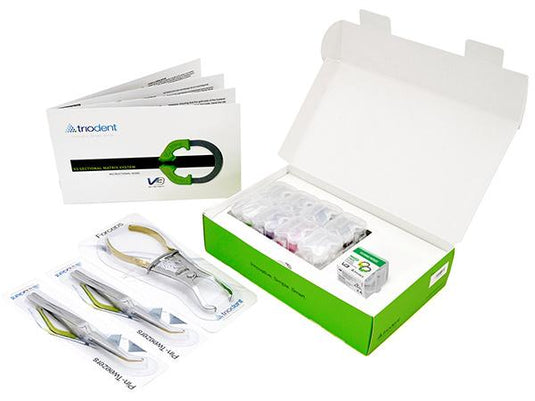
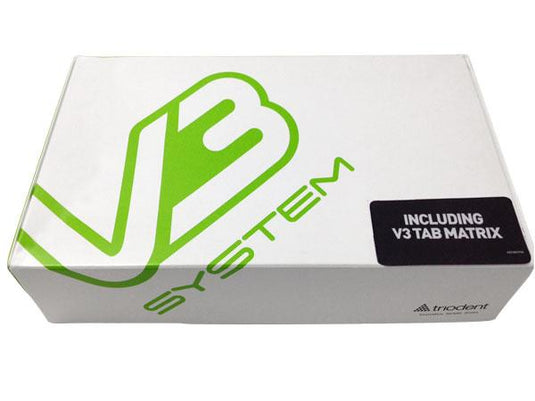
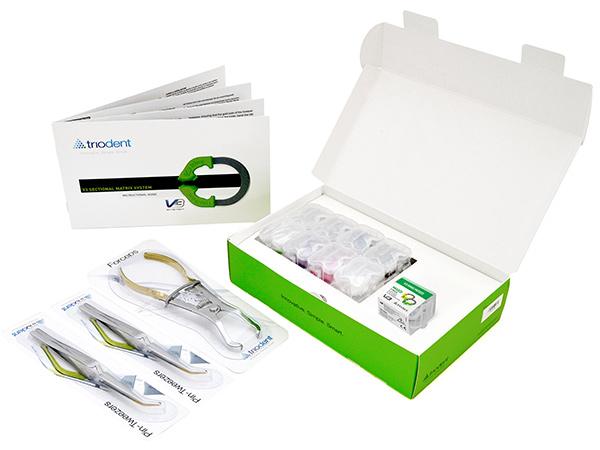
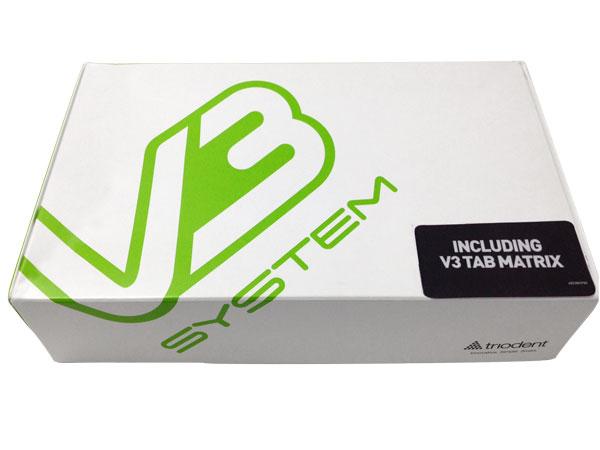
- Product Details
- Clinical Technique
- Technical Details
- Video
- Testimonials
- Kit Contents
- FAQ
- Resources
All of the products in the Triodent® V3 Sectional Matrix System work collectively to achieve consistently tight contacts with high-quality, anatomically accurate Class II composite restorations. This Triodent V3 Sectional Matrix System is an integrated system with nickel-titanium V3 Rings that offer the widest indications for use of any sectional matrix ring, anatomically shaped V3 Matrix Bands, and adaptive, self-guiding Wave-Wedges. Other features and benefits include:
- Predictable, tight contacts
- Restorations that accurately replicate natural tooth anatomy
- Minimal finishing
- Ideal separating force
- Great results with wide cavities and missing cusps
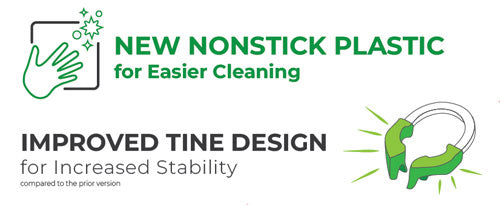
Indications for Use
Use the Triodent V3 Sectional Matrix System for Class II restorations including back-to-back MODs.
Palodent Plus Matrix System
-
To protect the mesial aspect of the adjacent tooth during cavity prep, a WedgeGuard from Triodent was used.

-
Cavity prep complete. At this point the metal shield of the WedgeGuard was detached from the Wave-Wedge, leaving just the wedge behind.

-
A medium V3 Tab-Matrix band was inserted between the wedge and the tooth. Both wedge and matrix were then secured with a Narrow V3 Ring.

-
The last increment of composite is placed.

-
Finished restoration.

Ideal Separation
One of the unique features of V3 Ring is that the ring itself — not the wedge — creates the interproximal separation. A fully tensioned V3 Ring is capable of producing 60–80µm of interproximal space, making it easy to accommodate the wedge and form the matrix around the tooth.
Long-Lasting Performance
The V3 Ring is designed to provide consistent results over many Class II restorations. Over time, however, the NiTi of the V3 ring can lose a bit of its memory—especially if the ring is left in the forceps too long. If this happens, simply place the V3 Ring in the notches of the forceps handle for 40–60 seconds. This will re-tension the V3 Ring, making it good as new!
Part of the Complete System
Every part of the V3 Sectional Matrix System has been expertly designed to work together, creating a totally seamless procedure. The unique V-shaped tines of the V3 Ring fit precisely over the wedge, and the wedge fits perfectly over papilla. And nearly every component of the V3 Sectional Matrix System is designed with pinholes to make placement and removal a snap with Triodent Pin-Tweezers.
The award-winning Triodent V3 Sectional Matrix System provides you with the essential components you need for reliable Class II restorations.
"The V3 wins easily. It is a fantastic system and I hope more people use it. It is better for dentistry. I have never enjoyed direct composites this much."
Martin Martic, DDS, Sudbury, Ontario
"I have been practicing for 26 years and have tried all different types of rings for composites. So far the V3 has been by far the best. Thanks."
Dr. Henry Tom, North Vancouver, BC
“Since I got my first V3 Ring I completely forgot what it’s like to have an open contact. Thank you to everyone at Triodent.”
Dr. Serge-Alexandre Bellavance, Lac-Beauport, QC, Canada
“Incomparably the most user-friendly, reliable composite matrix system on the market. Impressively tight contacts every time! I’ve already been telling all my fellow dentists about it since I started using the system. Love the Wave-Wedges too. It’s amazing that something so anatomically correct and functional hadn’t been invented before.”
Dr. Noelle Bunt, Trenton, Ontario
“The V3 Ring is used multiple times every day in my office and without it I cannot imagine having a good contact and well contoured composite fillings.”
Dr. Harry Weingarten, Ontario, Canada
“V3 simplified placement of matrices. Before, the tines of the ring always interfered with the wedge. Now that’s no longer the case and the ring goes on without fuss.”
Dr. Roger Chan, BC, Canada
“We find that the V3 Ring gives us more consistent contacts than other systems that we have used. The contour of the matrix gives a more curved surface. The nylon wedges help close the band around some root concavities.”
Dr. Steve Deneka, Cornwall, Ontario
“I no longer have to worry about whether or not I will have a contact when doing a proximal composite. The V3 Ring has made establishing proximal contacts a breeze. Furthermore, the ease in replacing proper physiologic and anatomical form and contour make for a functional, esthetic and long-lasting restoration. It is our matrix system of choice!”
Dr. John Hubbard, Calgary, AB
V3 Sectional Matrix System Kit (Item Number: 303301) includes:
- 1 x V3 Ring Universal (Green)
- 1 x V3 Ring Narrow (Yellow)
- 1 x Forceps
- 2 x Pin-Tweezers
- 25 x Wave-Wedges Small (White)
- 25 x Wave-Wedges Medium (Pink)
- 25 x Wave-Wedges Large (Purple)
- 25 x V3 Tab-Matrices 3.5mm
- 25 x V3 Tab-Matrices 4.5mm
- 25 x V3 Tab-Matrices 5.5mm
- 25 x V3 Tab-Matrices 6.5mm
- 25 x V3 Tab-Matrices 7.5mm
Q. Do V3 Rings produce tight contacts?
A. Yes. Experts agree that the Triodent sectional matrix system – using the V3 Ring – is the surest way to achieve tight contacts since the lateral spring pressure acts like a McKean orthodontic tooth separator1. A V3 Ring IS a sectional matrix. The only functional differences between the V3 Ring system and other sectional matrices are:
- The V3 Ring is particularly good at holding the matrix in a full anatomical curve.
- The V3 Ring traps the matrix on the shoulders of the tooth and prevents it from slipping and moving away from the neighbouring contact point.
- The V3 Ring spring is made from nickel-titanium (NiTi) and is very resilient.
- The V3 Ring spans wide cavities.
- The retention is better.
- The tooth separation is better as the lateral force of the spring is greater.
When you think about it, it can’t help but produce excellent contacts.
1Dental Clinics of North America, Vol 45, # 1, Jan 2001, p87.
Q. Can V3 Rings be used on wide cavities?
A. Yes. The anatomically-shaped tines grip on both adjacent teeth and this prevents the spring from falling into wide cavity preps (like other sectional matrices).
Q. Can V3 Rings be used when a cusp is missing?
A. Yes. Since the tines grip on both teeth on each side of the contact and also low down near the gingival margin, a V3 Ring can often be used when a cusp is missing. Depending on the anatomy, it is sometimes best to build up the bulk of the cusp before placing the V3 Ring.
Q. Can V3 Rings be used on primary teeth?
A. Yes. The V3 Ring comes in two sizes – Universal (green) for molars and Narrow (yellow) for premolars and primary teeth.
Q. What degree of separation is achieved with the V3 Ring?
A. The ring will create a separation of 60-80 microns. This is greater than the thickness of two Triodent matrices and is sufficient separation to restore two adjacent Class II cavities at the same time.
Q. Can V3 Rings be sterilized and re-used?
A. Yes. They are designed for re-use and have been tested successfully through 800 autoclave cycles. The rings should be steam-autoclaved at a maximum temperature of 135°C. Other methods of sterilization run the risk of damaging or staining the rings. Chemical sterilization will void the warranty.
Q. How do I get bonding agent off the V3 Ring?
A. The best course of action is to place the ring(s) in a beaker of warm water immediately after removing from the tooth. After that, you can proceed to scrub with a soft brush and/or plastic spatula to remove any debris (composite, bond) PRIOR to ultrasonic cleaning or autoclave. Once that material is baked on, it can be hard to remove. Any material should be removed immediately following ring removal with a flat plastic instrument and rings rinsed in water before autoclaving.
Q. How can the extra cost of V3 Rings be justified?
A. V3 Rings are not much more expensive than other competing systems and they produce better results with less frustration and time spent. They are also made of NiTi and glass-fibre reinforced plastic, which lasts longer. The cost of the consumable V3 Tab-Matrix is similar to other sectional matrix bands. In addition, think how much it costs you when you have to re-do a proximal restoration because of a poor contact.
Q. Do V3 Rings work equally well on all teeth?
A. The V3 Ring is a very versatile system and no other matrix system comes close in this respect.
Q. Do I have to hold the contact point with a burnisher while light curing? Could I use a regular matrix and hold the contact and then why would I need a V3 Ring?
A. We always suggest this because it is so easy to do and avoids the bad contact caused by the matrix not being in contact with the neighbouring tooth. Quite often it is impossible to see if the matrix is actually touching, so holding is just a precaution. We believe this issue is the single main cause of REALLY bad contacts. The V3 Ring’s function is to separate the teeth (orthodontically) and wrap the matrix.
A regular matrix (Tofflemire), when used on a Class II, has the effect of moving the tooth in the wrong direction by the thickness of the matrix (because you have to get the matrix through the intact side). This means that you have to overcome TWO thicknesses of matrix to get a tight contact. Tofflemires also tend to produce cylindrical, “tin can”, restorations with a poor contour and a contact just at the marginal ridge. This method has been found to be unpredictable by most who have tried it.
Q. Which style of clamp should I use to hold the rubber dam in place?
A. Often there is room for both the clamp and the V3 Ring. Our general advice is to use wingless clamps if space is going to be an issue. For example, on a #30 tooth, try a W3 or W7. Some brands of clamp leave more room than others. Don’t dismiss winged clamps entirely. If possible, place the clamp distal of the tooth being treated. Many dentists also use Wave-Wedges routinely to help keep the dam in place.
Q. Does the V3 Ring work if you are doing three teeth in a row i.e. #12DO, #13MOD, and #14MOL?
A. We suggest that you prep all at once, place the matrices on all teeth and then place initial composite layers on all three teeth. Then finish layering 12 and 14 and pull the matrix off of 12 and 14. Next, push the wedge in farther between 12-13 and 13-14, burnish the contact on the M and D of 13 and place the final layer on 13. Then finish all three at the same time.
Q. With the V3 Ring is it best to do them all separately start to finish or would you do 12 and 14 together and then 13 by itself?
A. Yes, you can do all four in a row if you want. You just need to make sure that the V3 Ring is separating the contact you are working on. You can move the V3 Ring along as you work, or stack rings. We suggest that you use just one V3 Ring as it allows that embrasure to open rather than the retainer rings working against each other. Build one contact at a time, then etch, bond and place bands and/or matrices all at once.
Q. The V3 Ring is a small piece of equipment to put in the patient’s mouth. What if it springs out or is dropped?
A. The V3 Ring is very stable on wet or dry teeth because of its strength and anatomically shaped faces. However, for added security tie floss to the ring.
Q. How do I re-tension the V3 Ring if the tines start to separate?
A. We use NiTi in our rings. It has remarkable strength and elasticity, so the ring will return to its original shape again and again. The V3 Ring may separate slightly over time with over-stretching but can be easily re-tensioned by placing it in the notches in the handles of the Triodent Forceps. Squeeze it like a nutcracker until the tines touch and the ring is as good as new. To prevent over-stretching, only open the ring as far as is needed to place it over the tooth. Also, try not to leave the ring open in the forceps for a long period of time.
Q. Can V3 Rings be used on MOD’s?
A. V3 Rings work really well on single Class II restorations and MOD’s. You can stack the V3 Rings or have one facing mesially and the other distally. The ring tilts up, away from the marginal ridge of the tooth, allowing more room for another ring to be placed underneath, on the next tooth. In most cases, it is advisable to place the rings in opposite directions.
Q. What’s the best way to restore a back-to-back MO or DO?
A. The easiest method for back-to-back Class II restorations is to complete one and then do the other. Doing both simultaneously can be faster but requires more operator skill. A Narrow (yellow) V3 Ring is recommended as more separation is necessary to overcome two thicknesses of matrix.
Q. What is the best way to restore a MOD with the V3 Ring?
A. The recommended method is as follows:
- Pre-wedge both M and D and complete cavity preparation.
- Slide M and D matrix into position and etch and bond.
- Place V3 Ring on M and build and cure M contact point.
- Move V3 Ring to D and build and cure D contact point.
- Complete occlusal surface and cure with C-Factor issues in mind.
Q. What is the best way to remove the matrix band when it’s in a tight contact area and stuck to the composite?
A. Push a thin, metal-blade instrument like a probe through the embrasure below the contact point to break the bond. Some clinicians also recommend flossing between the restoration and the band.
Q. Can I place the Wave-Wedge with the V3 Ring in place?
A. Yes. The V-shaped tines of the V3 Ring allow you to place a wedge without removing the ring. And because the Wave-Wedge has a hollow underside, you can slide a second wedge from the opposite side to the first.
Q. When doing a MOD, the matrix band side extrusions are too long and get in the way of the opposing matrix band?
A. The easy way around this is to place a V3 Ring on the first tooth, trapping the matrix band in place, then bend the protruding ends of the matrix backwards to make room for placement of another band on the opposite side of the restoration.
Q. Which style of rubber dam clamp should I use on, for example, a #30, that will not interfere with the V3 Ring?
A. Firstly, it is usually better to use a wingless clamp, say a W3 or W7, but there are other options to consider, like an 8a or a serrated premolar clamp. Yet another thing to try is to use a normal clamp, rotated slightly, on the #31.
Q. Sometimes when I place the V3 Ring on the SuperCurve matrix, the ring and matrix slip up the tooth. How can I prevent that?
A. This is most likely to occur on the buccal of lower molars and lingual of upper molars. If it happens, try placing the ring mesially instead of distally. Otherwise, wedge from both sides with Wave-Wedges or use the hard V-Wedge to secure the matrix. It’s a good idea to push down on the ring immediately after placement while it is still in the forceps to make sure the ring is fully seated on the undercuts, and keep your finger firmly against the matrix tab until you have released the forceps to ensure there is no slippage.
View article How the Triodent V3 Ring Solves Restorative Issues from Dental Products Report by Dr. John C. Comisi, DDS, MAGD.
View the Triodent V3 System Product Sheet.
View the Triodent V3 System IFU.



